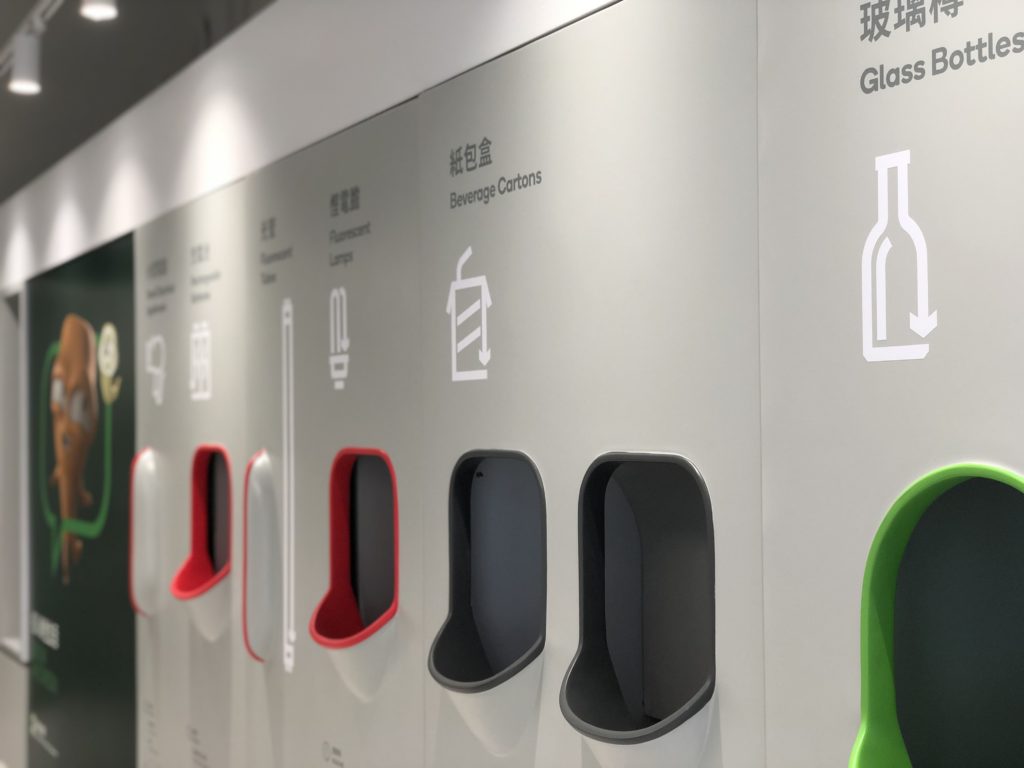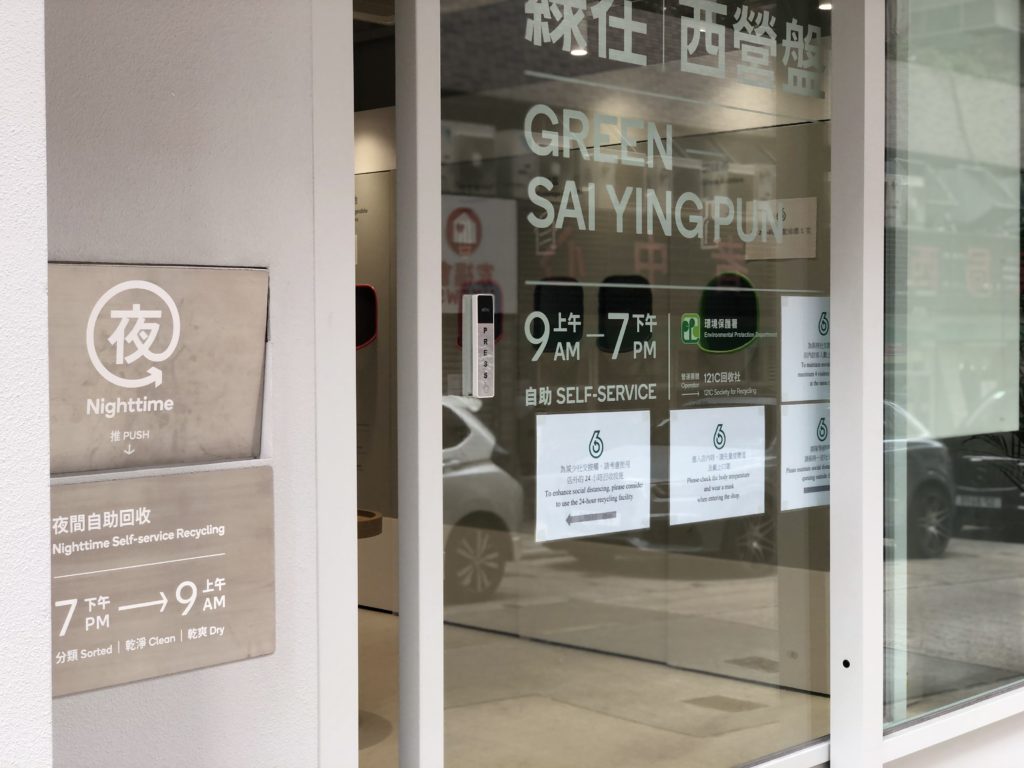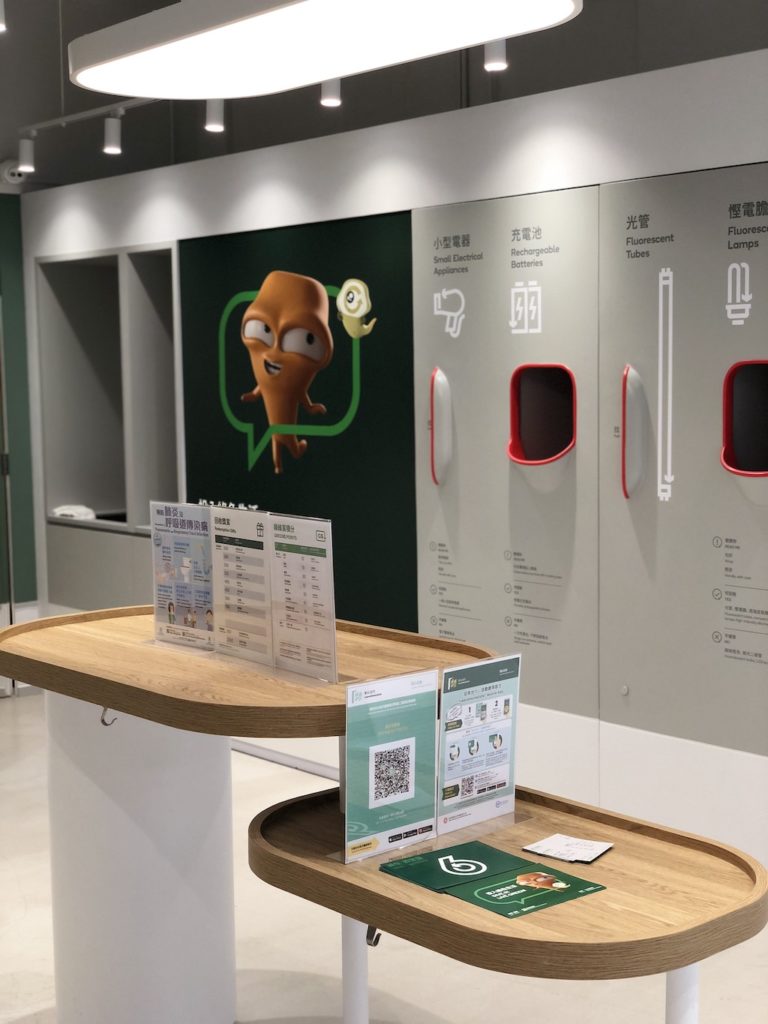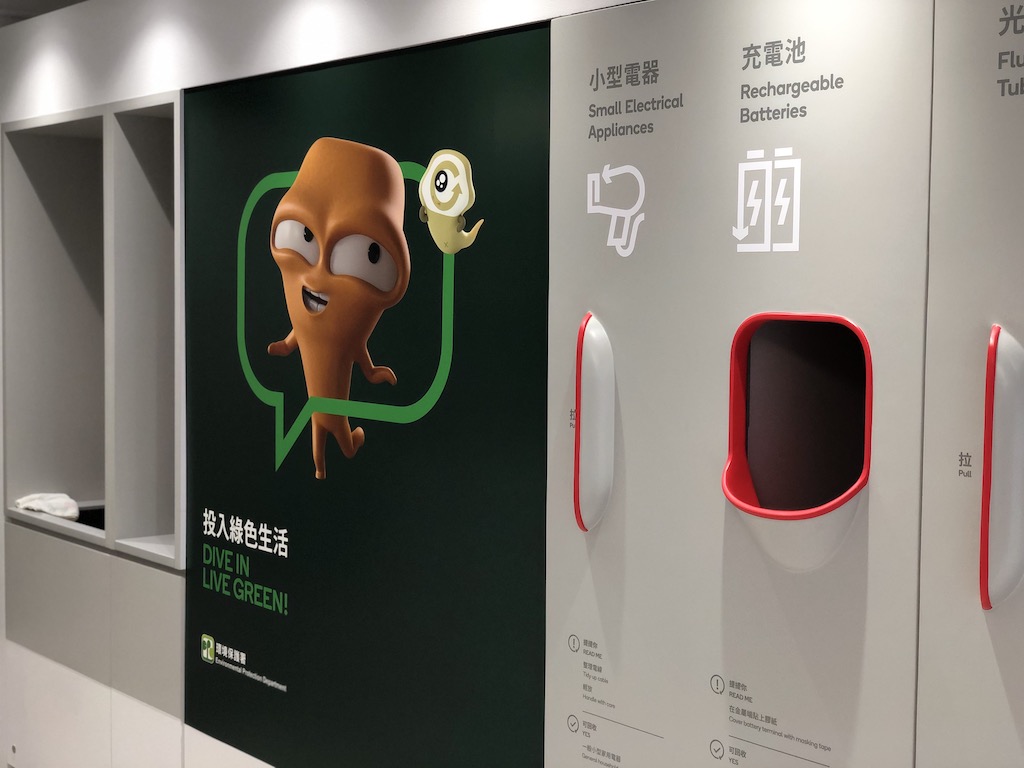8 Mins Read
The city’s landfills are running out of space and we need to reduce our waste ASAP- that’s the general idea behind the latest waste separation programme set up by the Hong Kong government, which takes in 8 types of recyclables including papers, metals, plastics, glass bottles, regulated electrical equipment, small electrical appliances, fluorescent lamps and tubes and rechargeable batteries. Hooray for lower waste living! For years, recycling in Hong Kong has been a murky business. Finally, we’ve got some options. Below we talk through everything you need to know about the new GREEN @ COMMUNITY stores that are popping up across the city and that one of our readers called “the Apple Store*” of recycling centres.
Back in 2005, the Environment Protection Department (EPD) released the Policy Framework for the Management of Municipal Solid Waste (2005-2014) that included a Community Recycling Network of outlets across the city to encourage the general public recycling efforts. In May 2013, the EPD followed up with the release of the Hong Kong Blueprint For Sustainable Use Of Resources 2013-2022, with the aim of increasing the recycling rate in Hong Kong to 55% by 2022. After testing various forms of domestic waste separation options for flexibility, convenience and cost-effectiveness, the EPD finally launched a new community recycling network this year, dubbed GREEN @ COMMUNITY complete with a new look, a new logo and a resident loyalty programme.
GREEN @ COMMUNITY: What is it?
The GREEN @ COMMUNITY network aims to educate and collect recyclables from the general public. It is divided into three types of outlets:
- 11 Recycling Stations: 9 are already operational, they are older than the new recycling stores- most opened between 2015 and 2019 and they have a real sense of community.
- 22 brand new Recycling Stores: conveniently located across the city (5 are already operational: GREEN @ TIN WAN, GREEN @ TIN HAU, GREEN @ SAI YING PUN, GREEN @ SHEUNG WAN, GREEN @ SAN HUI, and the rest are expected to launch before the end of 2020.
- 100 Recycling Spots: opening soon in a pop up format, these will be located near residential buildings where waste separation facilities are limited.
For the full list of locations and addresses, check here.

Notes From A Consumer Looking To Recycle in Hong Kong
I can’t think of a better neighbourhood to be a zero waster than Sai Ying Pun. You can find almost any food/grocery item in an unpackaged format, there are loads of small food shops selling loose handmade noodles, tofu and wet market for everything. It’s also one of the best places to live if you are a committed recycler. First of all, we have a compost bin (hosted by HK Community Composting) and we have the Community Recycling Outlet 121C located on Second Street, as well as 營盤耕作 Go Green SYP, a pop-up Green Station that took place every Tuesday in front of our local wet market until Covid-related reduced gathering regulations forced them to stop.
As great as these options are, there were some drawbacks, especially for people who are new to recycling. Not-always-convenient opening hours, restrictions on what is collected, a lack of clear guidelines on how to prepare your recyclables, language barriers for those of us who don’t speak Cantonese…but what was always clear was how popular these efforts were- the Tuesday pop ups were always packed with Sai Ying Pun residents eager to recycle!
First Hand Experience: Here’s What Happened When I Visited A Hong Kong Recycling Store
Conveniently located on First Street in front of the Sai Ying Pun MTR exit, the GREEN @ SAI YING PUN store is open daily from 9am to 7pm with a self-service option when the store is closed- a mailer box located next to the entrance of the store allows residents to drop recyclables as long as they are pre-sorted, clean and dry. The stores are also prepared for Covid life. For in-store visits, a maximum of four members of the public may visit the service at any time, there is a temperature check at the entrance of the store, and hand sanitisers are available to all visitors. Further, all the recycling cabinets are cleaned and sanitised every two hours.
As I entered the very modern store, I was greeted in both Cantonese and English and I was immediately in the centre of the recycling bins. The design is very appealing, clean and clear – the Apple store reference is on point. The space is cleverly laid out. I immediately noticed a washing station in the corner, a very important add as all recyclables in Hong Kong must be rinsed before being dropped in the recycling bins. Personally, I find that rinsing recyclables prior to taking them to the store make them easier to store in a small apartment.

Next to it is a drinking water station that I can use to refill my bottles, another useful and meaningful addition, not only does it allow citizens to access free, safe drinking water, it educates them about reducing our plastic bottles consumption. An eye popping 5.2 millions plastic bottles are sent to landfill every day in Hong Kong (and that’s a really old number, current figures must be far worse) even though our local tap water in safe to drink and there are loads of excellent home filtration systems available.
There’s also the recycler loyalty programme, termed Greeny Coins smart card. Basically, you need to bring over 2KG of recyclables in order to qualify and get issued a GREEN$ Card (Note: it’s only 1KG if you go within the first two weeks of the store’s opening). Following that, every time you bring recyclables, the store will weigh them, and you will earn the corresponding number of points which can then be be used to redeem gifts provided by EDP (think noodles, towels, food seasonings). It’s great to see an incentive scheme in place, though personally my main motivation to recycle is landfill reduction.
The stores also aim to offer educational activities, but it’s too early to share more about this as as the stores have only just opened and Covid makes events difficult. Each store has its own Facebook page (here’s the Sai Ying Pun one) where they announce new initiatives and where residents can ask questions.
Avoiding Wishcycling
Despite what it may seem, it’s better to recycle fewer items whilst following the right guidelines than to “whishcycle” – i.e. throwing anything and everything in recycling bins with the best intentions. Whishcycling is counterproductive and actually worse overall than doing nothing as it can damage the recycling facilities!
In the end, what got most excited during my visit were the very clear guidelines on each bin (I cover these in extensive detail below). I’ve been a low waste social media activist for many years now and one of the most common comments I receive is that people are confused about what they can recycle and how they can recycle. The recycling store makes it very clear and helps educate the public about how to prepare their recycling, not to mention the agents at the store are very helpful (during my visit I saw one gently show another visitor how to cut and recycle their Tetra Pak carton). This feels like a huge step forward. If recycling rates are going to increase, it’s key that we the public do our part right by following the guidelines that facilitate the recycling process and protect garbage collectors.

So, What Can You Recycle? Complete Guide To Hong Kong Recycling Stores
Thanks to clear guidelines I realised that we can recycle more than I expected in the new Community Stores. Below a full guide so you are prepared before you go, in terms of what’s allowed, what’s not allowed .
GLASS BOTTLES
- Do: empty, rinse and handle with care
- Yes: beverage bottles, sauces, jars
- No: mirrors, window glass, cooking ware, glass furniture, drug and medical containers
Related Programme:Producer Responsibility Scheme (PRS) on Glass Beverage Containers
BEVERAGE CARTONS (aka Tetra Paks)
- Do: cut, rinse and remove plastic parts
- Yes: milk cartons, aluminium foil cartons, paper cups and paper plates
Related Programme: https://www.milmill.hk
FLUORESCENT LAMPS & TUBES
- Do: wrap them in paper and handle with care
- Yes: Fluorescent tubes compact fluorescent lamps and high intensity discharge lamps (HDL)
- No: incandescent bulbs and led bulbs
Related Programme: Fluorescent Lamp Recycling Programme
RECHARGEABLE BATTERIES
- Do: cover terminal battery with masking tape to prevent contact between terminals or other metal surfaces during storage and transport
- Yes: portable rechargeable batteries
- No: single use batteries, vehicle lead acid batteries
SMALL ELECTRICAL APPLIANCES
- Do: tidy up cable
- Yes: general household appliances and mobile phones
- No: appliances for clinical use
Related Programme: Rechargeable Battery Recycling Programme
METALS
- Do: empty and rinse
- Yes: tin and aluminium cans, other metals
- No: aerosol cans, chemical containers
Related Programmes: Source Separation of Domestic Waste, Programme on Source Separation of Commercial & Industrial Waste
PLASTIC BOTTLES
- Do: empty and rinse
- Yes: beverage bottles, personal care product bottles, cleansing product bottles
- No: medicine bottles and chemical bottles
Related Programmes: Source Separation of Domestic Waste, Programme on Source Separation of Commercial & Industrial Waste
OTHER PLASTICS
- Do: rinse
- Yes: plastic bags, single use utensils and containers, packaging materials, Styrofoam, CD
- No: composite materials, rubber and silicon
Related Programmes: Source Separation of Domestic Waste, Programme on Source Separation of Commercial & Industrial Waste, Full Implementation of the Plastic Shopping Bag Charging
PAPER
- Do: remove non-paper materials, e.g. plastic coated pages, plastic tape and paper clips
- Yes: newspapers, books and magazines, office papers and carboard
- No: tissue paper, hand towel, thermal paper and plastic coated paper
Related Programmes: Source Separation of Domestic Waste, Programme on Source Separation of Commercial & Industrial Waste
Last Tip: if you don’t know where or how to recycle something, ask your hosts at the recycling store- they will be delighted answer your questions.
*Editor’s Note: The GREEN @ COMMUNITY stores on Hong Kong island were designed by local design studio One Bite Design, also the creative force behind the Green Ladies shop at The Mills and the branding designer Codesign.
All images courtesy of Nathalie Kientz Ibanez for Green Queen Media.



